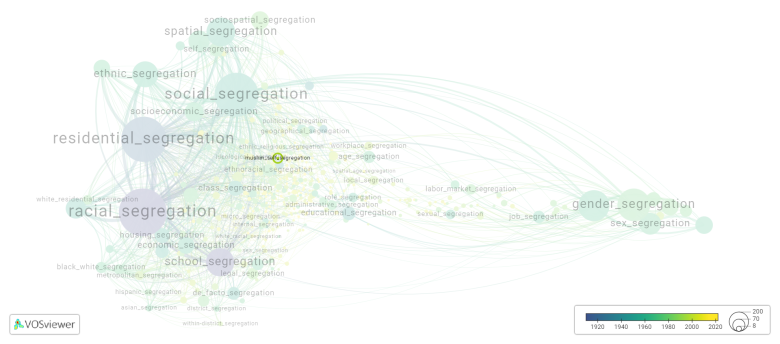Muslim self segregation: Difference between revisions
(Creating page) |
(Creating page) |
||
| (4 intermediate revisions by the same user not shown) | |||
| Line 9: | Line 9: | ||
Ultimately, the issue of Muslim self-segregation is complex and varies depending on the context and individual circumstances of each community. It is important to consider the factors driving self-segregation and work towards creating more inclusive and integrated societies where all individuals can feel a sense of belonging. | Ultimately, the issue of Muslim self-segregation is complex and varies depending on the context and individual circumstances of each community. It is important to consider the factors driving self-segregation and work towards creating more inclusive and integrated societies where all individuals can feel a sense of belonging. | ||
==== | ==See also== | ||
==Related segregation forms== | |||
Muslim self segregation is frequently discussed in the literature with the following segregation forms: | |||
[[self segregation]], [[ethnic residential segregation]] | |||
[[File:muslim_self_segregation.png|780x780px]] | |||
This visualization is based on the study [[Segregation_Wiki:About| The Multidisciplinary Landscape of Segregation Research]]. | |||
For the complete network of interrelated segregation forms, please refer to: | |||
* [https://tinyurl.com/2235lkhw First year of publication] | |||
* [https://tinyurl.com/2d8wg5n3 Louvain clusters] | |||
* [https://tinyurl.com/223udk5r Betweenness centrality] | |||
* [https://tinyurl.com/244d8unz Disciplines in which segregation forms first emerged (Scopus database).] | |||
==References== | ==References== | ||
==Notes== | ==Notes== | ||
<references /> | <references /> | ||
{{NoteAI}} | {{NoteAI}} | ||
==Muslim | ==Muslim self segregation appears in the following literature== | ||
Phillips D. (2006 | Phillips D. (2006). Parallel lives? Challenging discourses of British Muslim self segregation. ''Environment and Planning D: Society and Space'', ''24''(1), 25-40. https://doi.org/10.1068/d60j | ||
Britton J. (2019 | Britton J. (2019). Challenging the racialization of child sexual exploitation: Muslim men, racism and belonging in Rotherham. ''Ethnic and Racial Studies'', ''42''(5), 688-706. Routledge.https://doi.org/10.1080/01419870.2018.1467030 | ||
Latest revision as of 07:17, 16 October 2024
Date and country of first publication[1][edit | edit source]
2006
United Kingdom
Definition[edit | edit source]
Muslim self-segregation refers to the tendency of some Muslim communities to live in separate, culturally homogenous neighborhoods or enclaves. This segregation can be due to a variety of factors, including a desire to preserve cultural traditions, fear of discrimination or Islamophobia, or simply a preference for living among others who share the same religion and values.
While self-segregation can provide a sense of community and support for Muslims, it can also lead to social isolation and lack of integration with the wider society. Critics argue that self-segregation can reinforce stereotypes and hinder social cohesion, while proponents argue that it is a natural expression of cultural identity and religious freedom.
Ultimately, the issue of Muslim self-segregation is complex and varies depending on the context and individual circumstances of each community. It is important to consider the factors driving self-segregation and work towards creating more inclusive and integrated societies where all individuals can feel a sense of belonging.
See also[edit | edit source]
Related segregation forms[edit | edit source]
Muslim self segregation is frequently discussed in the literature with the following segregation forms:
self segregation, ethnic residential segregation

This visualization is based on the study The Multidisciplinary Landscape of Segregation Research.
For the complete network of interrelated segregation forms, please refer to:
References[edit | edit source]
Notes[edit | edit source]
- ↑ Date and country of first publication as informed by the Scopus database (December 2023).
At its current state, this definition has been generated by a Large Language Model (LLM) so far without review by an independent researcher or a member of the curating team of segregation experts that keep the Segregation Wiki online. While we strive for accuracy, we cannot guarantee its reliability, completeness and timeliness. Please use this content with caution and verify information as needed. Also, feel free to improve on the definition as you see fit, including the use of references and other informational resources. We value your input in enhancing the quality and accuracy of the definitions of segregation forms collectively offered in the Segregation Wiki ©.
Muslim self segregation appears in the following literature[edit | edit source]
Phillips D. (2006). Parallel lives? Challenging discourses of British Muslim self segregation. Environment and Planning D: Society and Space, 24(1), 25-40. https://doi.org/10.1068/d60j
Britton J. (2019). Challenging the racialization of child sexual exploitation: Muslim men, racism and belonging in Rotherham. Ethnic and Racial Studies, 42(5), 688-706. Routledge.https://doi.org/10.1080/01419870.2018.1467030
